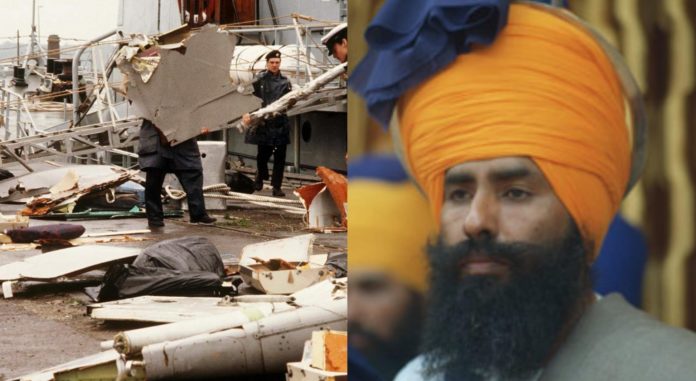Sagarika Mitra, JAN KI BAAT Content Head, examines grave Intel failures by Canadian authorities in the 1985 Kanishka terror attack that cost 329 innocent lives
On June 4, 1985, a mere 18 days before the tragic Kanishka Bombing, Canadian Intelligence (CSIS) agents were monitoring the activities of Talwinder Singh Parmar, the mastermind behind the Air India Flight 182 bombing. Their surveillance was conducted with the primary goal of gathering evidence to prevent any potential terrorist activities.
Upon receiving crucial inputs, Canadian intelligence agents tracked Parmar’s movements, signifying their awareness of his suspicious activities. Their surveillance eventually led them to the residence of Inderjit Singh Reyat, another key figure embroiled in the bombing conspiracy. Reyat, who later became the sole individual convicted in the case, was under close watch. While observing Parmar and Reyat, CSIS agents witnessed Reyat transporting a device into a remote area, likely a wooded location. This moment was highly significant, as it strongly suggested Reyat’s involvement in bomb-making activities, raising a red flag of the highest order.
However, a grave lapse in the surveillance operation occurred when CSIS agents heard a loud explosion emanating from the vicinity where Reyat was conducting his activities. Shockingly, they dismissed this critical development as a mere gunshot. In stark reality, this deafening bang resulted from Reyat’s testing of a blasting cap, an essential component in assessing the bomb circuit for the impending attack on Air India Flight 182.
The failure to connect these vital dots and take immediate action was an egregious oversight. The fact that Inderjit Singh Reyat was conducting a test explosion should have set off alarm bells and prompted the CSIS agents to intervene, potentially averting the tragic events that unfolded subsequently. But regrettably, they did not seize this opportunity.
In retrospect, this surveillance operation on June 4, 1985, represents a glaring example of missed opportunities and intelligence failures. CSIS agents were fully cognizant of suspicious activities, witnessed components associated with bomb-making, and even heard an explosion. Yet, shockingly, they did not deem these occurrences significant enough to alert law enforcement or to initiate a search of the suspects.
This incident was just one of the many in a series of glaring lapses that characterised the investigation conducted by Canadian authorities before and after the terror attack. This article examines the grave oversights of Canadian intelligence, offering an insight into the events that underscores the persistent pattern of intelligence failures and the lost chances to prevent this tragedy. These oversights allowed Khalistani terrorist Talwinder Singh Parmar to execute an unforgivable act of terror, claiming the lives of 329 innocent people.
Instance 1: Months before the fateful day, informants desperately contacted Canadian security services with alarming intelligence about a bomb plot. Gerry Boudreault, an acquaintance of Parmar, reported that Parmar offered him $200,000 to plant a bomb on an Air India plane. Gerry’s warning was disregarded.
Instance 2: Harmail Singh Grewal, another informant, informed CSIS and RCMP of the same plot. He revealed a plot involving Sikh extremists who aimed to plant a bomb on an Air India flight. Despite his cooperation, CSIS and RCMP dismissed him as unreliable after a sentencing deal fell through.
Instance 3: In June 1985, an RCMP informant, Paul Besso, was working undercover and recorded conversations about a plot against Air India. Shockingly, despite having transcripts, the RCMP did not take these conversations seriously, allowing crucial evidence to slip through their fingers.
Instance 4: Another source reported that Gurmej Singh Gill, a leader of Babbar Khalsa, had threatened that anyone flying Air India would be killed. The information was neither substantiated nor refuted, adding to the growing list of disregarded warnings.
Instance 5: Before June 9, 1985, Talwinder Singh Parmar is believed to have visited a Gurudwara near Toronto and warned the congregation that it would be unsafe to fly Air India. An informant relayed this ominous message to the authorities, yet again, to no avail.
These instances of inaction and negligence ultimately culminated in the tragedy of June 23, 1985. A bomb hidden in a suitcase exploded at New Tokyo International Airport, killing two baggage handlers. An hour later, Air India Flight 182 disintegrated off the coast of Ireland – the worst act of terror plotted on Canadian soil by terrorists was executed mid-air.
Even after the catastrophe, the Canadian intelligence community mishandled the case. Journalists who covered the trial and investigation wrote extensively about erased tapes, missing transcripts, and the assassination of witnesses. Only one person, Inderjit Singh Reyat, was convicted, and he too was later released on parole in 2016. Today he’s a free man.
As the world watches different layers of the diplomatic faceoff between India and Canada unravel everyday, one must not forget Canada’s history of shielding terror and letting terrorists behind Kanishka go unpunished.

